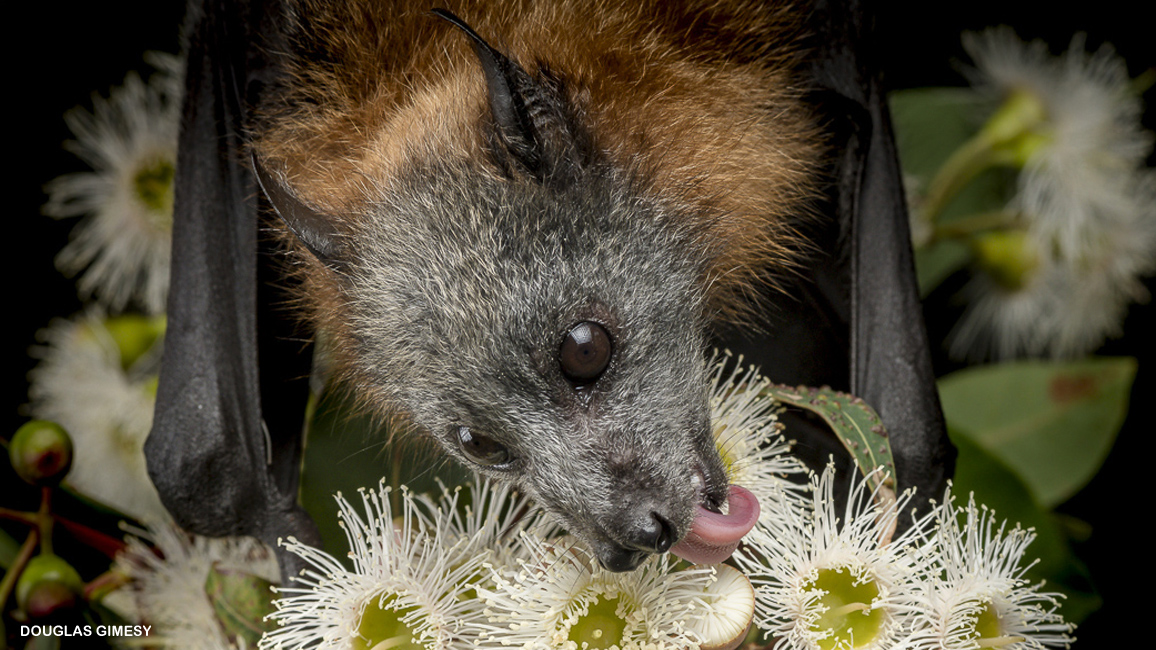
Flying Foxes
By Kate Hofmann; Photos by Douglas GimesyOn summer nights above the city of Melbourne, Australia, thousands of flying foxes take to the skies. Foxes that fly? Have we gone batty?

Flying foxes are not foxes at all. They’re large bats with furry, fox-like faces. They’re also known as fruit bats, because they fly out at night to find fruit, pollen, and nectar. Take a look at the nectar-lapping tongue on the one at far right above.
As the bats eat, they help with the important work of spreading pollen and seeds. Pollen sticks to their fur, traveling with them from one flower to another. And after they eat fruit, they poop out the seeds in new places!
There are four species of flying foxes in Australia. The ones in this story are all grey-headed flying foxes.
During summer in Melbourne, nearly 50,000 of these bats roost (come together to rest or sleep) in the trees in a park along the Yarra River, which runs through Melbourne. By day, they hang upside down with their wings wrapped around themselves. At night, each bat may fly almost 25 miles to visit flowering and fruiting trees around the city. When a mother has a young pup, it goes with her, holding on and even nursing as she flies.

DINNER IS DANGEROUS
When thousands of grey-headed flying foxes roost or fly together, there may seem to be plenty of them. But there aren’t nearly as many as there once were. Scientists are worried that the species could be extinct in 100 years. Why? Life has gotten a lot harder for flying foxes. Many of the forests where they once lived have been cut down. The bats may find flowers and fruits in people’s yards and orchards. But the trees are often covered with netting to keep wildlife out. Flying foxes get caught in the nets. They sometimes become tangled and damage their fragile wings.
Another danger is barbed wire fences. The bats get caught and injured by the sharp barbs. The bats aren’t always safe even when they fly higher up in the air. If they accidentally fly into power lines, they can be electrocuted.
HEATING UP
One of the biggest threats of all for grey-headed flying foxes is a changing climate. In the past year, the bats were hit with three disasters. First was a drought (DROWT). Less rain than usual fell, so many trees didn’t make flowers or fruit. This meant much less food for flying foxes.
Then there were heat waves. Flying foxes are built for Australia’s hot summers. But when the temperature rises above 104°F, they can die from heat stress. Temperatures soared last summer and caused many thousands of bats to die.
The bats in Melbourne try to cool down by fanning their wings, moving into the shade, or dipping their bellies into the river. But when it’s too hot, the bats overheat and can’t fly. They may even fall from their roosts.
Worst of all, along with last summer’s heat came huge wildfires. Millions of acres in Australia burned. Luckily, the flying foxes in Melbourne were not in the fire zone. But important parts of their habitat were destroyed to the north, where many migrate to in the winter months in search of food.

SAVING FLYING FOXES
The good news is that people in Australia are learning just how important flying foxes are and how to help protect them. In their own yards, people can plant native trees that provide more food for the bats. If they must use fruit-tree netting, they can choose a bat-safe kind with smaller holes. And they can take down unneeded barbed wire, especially near trees that flying foxes visit.
Meanwhile, some people work extra hard to help flying foxes. Wildlife rescuers do their best to save bats that get injured in nets or by wires. When baby bats lose their mothers, rescuers take care of the orphans. And when heat waves threaten the whole colony, they spray water to cool the habitat and bring suffering bats in for care.
The caregivers report that the bats are curious and smart. They are very social, too. They learn to know their caregivers and chirp to them when they see them. The bats seem to enjoy the company of their human friends. Sometimes they even hang on for rides as the rescuers go about their care!
BACK TO THE WILD
When rescued flying foxes are ready, they go back to the wild. Sometimes they can simply be released. But for babies and others that have been in care for a long time, it’s a slow process called “soft-release.” These bats start in a small outdoor cage where they build their flying skills. Then they move to a larger pen. At first, the rescuers feed the bats inside the pen. Later, they open a hatch and place food outside. The bats gradually learn to find food on their own and rejoin the wild colony.
















